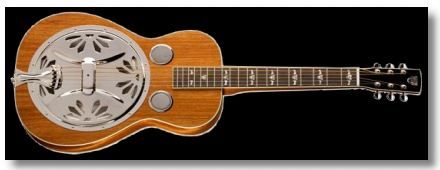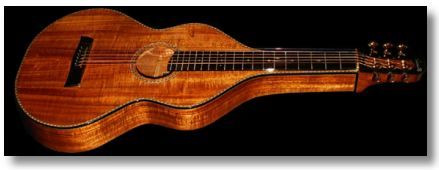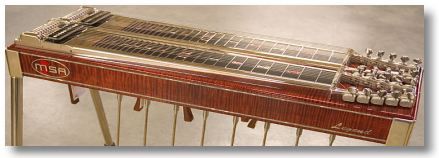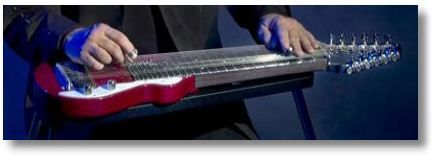“Steel Guitar- when you hear it- you know it”- Jay Leach
To hear sounds and styles that the below instruments can produce, please click on the player.

The resonator guitar is commonly referred to as a Dobro and is an acoustic instrument that uses one or more metal discs under a metal bridge that give the instrument its characteristic sound. While the some of these instruments may be played like a standard guitar, a more common use is to play as a slide instrument. Originally coined by the Dopyera brothers when they formed the Dobro Manufacturing Company, the name was sold to the Gibson Guitar Company and they currently manufacture resonator guitars with the Dobro name. There are a number of other popular resonator guitar manufacturers and, while not limited to only one type of music, it is most commonly heard in the bluegrass and folk genres.
![]()

Weissenborn guitars were originally made in Los Angeles in the mid-late 1920’s by Hermann Weissenborn and are characterized by a unique body and a hollow neck and generally played as acoustic slide instruments. While they remained local treasures by a select few the popularity of these instruments has risen dramatically since the 1990’s primarily due to well known players such as string wizard David Lindley and others rediscovering the wonderful tone that is characteristic to these instruments. As a result of this, there are a number of manufacturers that currently produce hollow neck guitars similar to the Weissenborn and they can be found from $400- $5000.
![]()

The development of the pedal steel guitar began in the 1940’s as a result of wanting to create different tunings from its predecessor- the lap steel guitar. One of the earliest records featuring the pedal steel guitar was in the 1950’s on a song by Webb Pierce called Slowly and featured Bud Issacs as the pedal steel player. Since that time many developments have brought the instrument into the 21st century as a sleek pedal and knee-lever based instrument that takes advantage of the note relationships in a key to form the common chords frequently played in that key with a minimal amount of bar movement. The pedals and knee-levers are used to vary the tension of the desired strings basically moving the note(s) to the bar rather than the fingers reaching for the note as is necessary to do when playing a conventional guitar.
![]()

The actual origins of the Hawaiian or lap steel guitar
may never be known for sure. As Brad Bechtel outlines on his Lap Steel Guitar page:
“Steel guitars were originally invented and popularized in Hawaii. Legend has it that in the mid 1890’s Joseph Kekuku, an Hawaiian schoolboy, discovered the sound while walking along a railroad track strumming his Portuguese guitar. He picked up a bolt lying by the track and slid the metal along the strings of his guitar. Intrigued by the sound, he taught himself to play using the back of a knife blade.”
Since that time the steel guitar has become popular in Hawaiian, Country, Country Swing, Rock and Roll, Gospel, Jazz and more recently has been found in the newer genres of music such as Sacred Steel and others proving that music is music- it is not the instrument that defines it rather it is what is in the technique and heart of the player that gives it meaning.